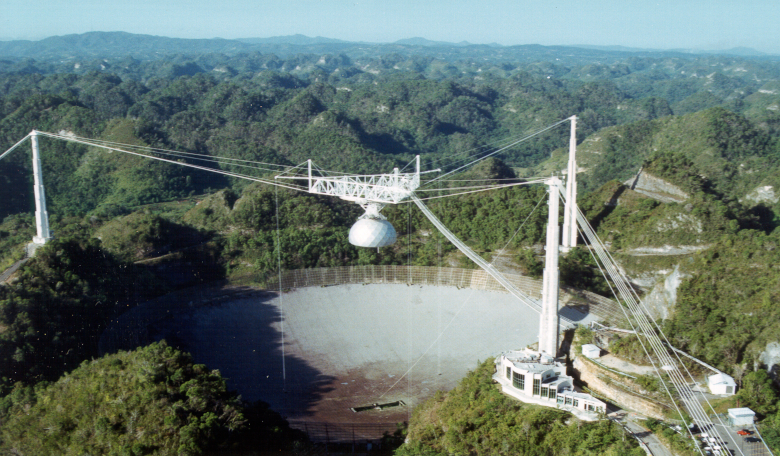It is a telescope that has captured the imagination of people everywhere, and not just astronomers, but soon the hills near the north coast of Puerto Rico will look somewhat different as damage inflicted from recent cable breaks has proven too catastrophic for the country’s beloved and iconic Arecibo Observatory, and repairing it safely is longer an option. As such the decision has been made to demolish the huge radio dish as soon as possible.
“Following a review of engineering assessments that found damage to the Arecibo Observatory cannot be stabilised without risk to construction workers and staff at the facility, the U.S. National Science Foundation will begin plans to decommission the 305-meter telescope,” say the NSF in a recent press release.
The NSF, who along with Universidad Ana G. Méndez and Yang Enterprises Inc. operate the observatory, say that the decision has been made after reports from a number of independent engineering companies deemed the telescope structure to be in “danger of a catastrophic failure.”
In addition, its cables, one of which recently snapped and tore through the dish leaving a significant gash, may no longer be capable of carrying the loads they were designed to support.
"Although it saddens us to make this recommendation, we believe the structure should be demolished in a controlled way as soon as pragmatically possible, " said the recommendation for action letter submitted by Thornton Tomasetti, one of the engineering firms drafted in to assess Arecibo’s structural integrity. "It is therefore our recommendation to expeditiously plan for decommissioning of the observatory and execute a controlled demolition of the telescope.”
Since the early 60s, the Arecibo Observatory has been an exemplary tool for breakthrough science and has been used by many astronomical disciplines to boost discoveries, including research into brown dwarfs, locating near-Earth objects (NEOs) understanding pulsars and helping to refine fundamental theories of gravity .
Most notable was its discovery of the first binary pulsar, B1913+16 in 1974. By precisely measuring the variations in pulse arrival times, scientists worked out that these superdense neutron stars which spun once every 59 milliseconds (ms), could be used as natural stellar clocks as they moved in accordance with predictions made by Einstein in his theory of General Relativity.
Arecibo was also famed for a radio message sent into space in 1974 which carried basic information about our planets and the people that live it on. Although meant as a demonstration of human technological achievement, rather than a real attempt to contact aliens, the observatory has since been used by SETI (Search for Extraterrestrial Intelligence) to help find technologically advanced civilisations.
And, although we now know that billions of exoplanets could potentially be residing in the Milky Way thanks to telescopes such as Kepler, the first was discovered using Arecibo in 1992. The famous radio dish is also used by NASA to characterise known NEOs.
Sadly, despite its world-wide, multidisciplinary use and unforgettable aesthetics, the second largest single-aperture telescope in the world – the first is China's Five Hundred metre Aperture Spherical Telescope (FAST) – is due for immediate deconstruction.
"Our question was not if the observatory should be repaired but how," said Ralph Gaume, director of NSF's Division of Astronomical Sciences in a statement. "But in the end, a preponderance of data showed that we simply could not do this safely. And that is a line we cannot cross."
The cultural and economic significance of Arecibo Observatory to Puerto Rico and the astronomers who used it cannot be understated and the loss of such an legendary structure will be felt for years to come.
“What I love the most about working with Arecibo is how it is a community institution; it has broadened Puerto Rican participation in science in immeasurable ways,” says Puerto Rican astronomer Kevin Ortiz Ceballos via Twitter, and one of many whose admiration for the observatory inspired them to study the stars.
After the telescope decommissioning, NSF has said it intends to restore operations at assets such as the Arecibo Observatory LIDAR facility – a valuable geospace research tool – as well as at the visitor center and offsite Culebra facility, which analyses cloud cover and precipitation data.
Although the radio dish will be decommissioned, its visitor center and offsite Culebra facility, which analyses cloud cover and precipitation data, as well as the Observatory’s LIDAR facility will remain operational, say NSF.
"Over its lifetime, Arecibo Observatory has helped transform our understanding of the ionosphere, showing us how density, composition and other factors interact to shape this critical region where Earth’s atmosphere meets space," said Michael Wiltberger, head of NSF's Geospace Section. "While I am disappointed by the loss of investigative capabilities, I believe this process is a necessary step to preserve the research community's ability to use Arecibo Observatory's other assets and hopefully ensure that important work can continue at the facility."
Work to begin a “controlled disassembly” of the 305 metre wide radio dish and its 900-ton instrument platform hanging 137 metres above is expected to begin as soon as a technical execution plan covering legal, environmental, safety and cultural requirements is delivered over the coming weeks.











